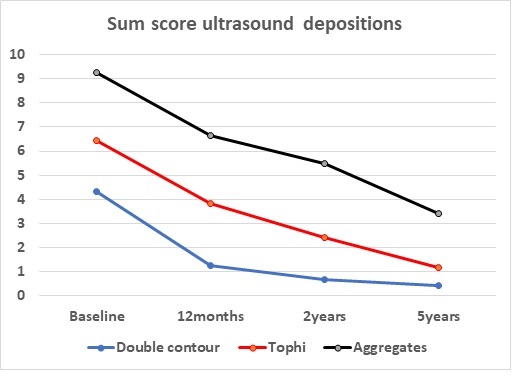Session Information
Session Type: Abstract Session
Session Time: 1:00PM-2:30PM
Background/Purpose: Ultrasound (US) is sensitive for detecting monosodium urate (MSU) crystal depositions in gout, described as double contour (DC), tophi and aggregates. Depositions decreased during the first year of serum urate lowering treatment (ULT) in the NOR-Gout study. Our objective was to explore the US changes in depositions after 2 and 5 years on ULT.
Methods: Patients with crystal-proven gout and a recent gout flare with serum uric acid (sUA) level >360 μmol/L were
consecutively included in the NOR-Gout study. During the first year they had frequent visits for ULT
adjustment to achieve sUA < 360 μmol/L (or < 300 μmol/L if clinical tophus) and US was performed at baseline
and after 3, 6 and 12 months. Patients were then followed by their general practitioner to keep the ULT target,
and met for study visits at year 2 and 5. The US assessment (General Electric E9) included a semi-quantitative
scoring of MSU crystal depositions using the OMERACT scoring system, with bilateral examination of
radiocarpal, metacarpophalangeal2, knee, ankle and metatarsophalangeal1 joints as well as triceps,
quadriceps, patellar (proximal and distal) and Achilles tendons and insertions. Sum scores of US depositions
(DC, tophi, and aggregates, respectively) were calculated, and changes from baseline were explored by paired
samples T-test.
Results: 209 patients were included (mean (SD) age 56.4 (13.8) years, time since first flare (disease duration) 7.9 (7.7)
years, 95.5% men). Mean (SD) sUA (μmol/L) during the study were 500 (77) at baseline, 341 (61) at 3 months,
327 (60) at 6months, 312 (49) at 12 months, 325 (70) at 2 years and 337 (83) at 5 years. The US sum scores (DC,
tophi, and aggregates, respectively) decreased during the study (p < 0.001 for all lesions) shown in the table and
figure. At 2 (n=172) and 5 (n=161) years, a sum score of zero was found in 70.9% and 83.2% respectively, for
DC, with corresponding percentages of 33.1 and 62.7 for tophi, and 7.6 and 23.6 for aggregates. At least one
flare was described by 26.6% between year 1 and 2, and 15.4% had ≥ 1 flare between year 2 and 5.
Conclusion: The amount of crystal depositions decreased not only during treat to target ULT the first year of the study, but
also when the patients were followed by their general practitioner between year 1 and 5. Patients and
clinicians should be encouraged to comply to ULT to remove the depositions in joints and tendons and thereby
reduce the burden of gout.
To cite this abstract in AMA style:
Hammer H, Karoliussen L, Terslev L, Haavardsholm E, Uhlig T. Continuous Reduction in Ultrasound Detected Crystal Depositions over 5 Years Follow-up: Results from the NOR-Gout Study [abstract]. Arthritis Rheumatol. 2024; 76 (suppl 9). https://acrabstracts.org/abstract/continuous-reduction-in-ultrasound-detected-crystal-depositions-over-5-years-follow-up-results-from-the-nor-gout-study/. Accessed .« Back to ACR Convergence 2024
ACR Meeting Abstracts - https://acrabstracts.org/abstract/continuous-reduction-in-ultrasound-detected-crystal-depositions-over-5-years-follow-up-results-from-the-nor-gout-study/


